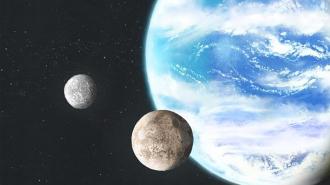Each year, the number of planets discovered orbiting other stars continues to grow, and many of them appear similar to Earth in their sizes and masses.
Yet while the latest advances in astronomy — such as the James Webb Space Telescope (JWST) — are allowing astronomers to study these distant worlds in ever more detail, there is one particularly pressing unanswered question: how many of them could realistically support life?
The key to answering this question partly lies in analyzing the chemical compositions of exoplanet atmospheres. Astronomers can do this by picking up the chemical signatures imprinted on the spectra of starlight after it passes through an exoplanet’s atmosphere.
These factors will be crucial for astronomers to consider when determining whether a newly-discovered exoplanet may be habitable.
In July 2022, such a spectrum was released alongside the first full-color images taken by the JWST – clearly showing the presence of water in the atmosphere of exoplanet WASP-96 b.
But chemical composition isn’t the only factor that affects a planet’s habitability. Just as we see on Earth, planetary climates are deeply interconnected with the configurations of their continents and oceans. This arrangement impacts their temperatures and the ways in which air and water move around their atmospheres.
These factors will be crucial for astronomers to consider when determining whether a newly-discovered exoplanet may be habitable. However, since even the JWST is not powerful enough to pick out details on exoplanet surfaces, such assessments can’t be made directly.
Virtual continents: To explore the issue in more detail, a team of researchers in Canada have examined the climates of virtual exoplanets, which they generated in computer simulations.
In their study, Evelyn Macdonald and colleagues at the University of Toronto investigated a series of simulated, Earth-like planets that were “tidally locked” with their host stars: rotating so that one side permanently faces the star, while the other remains in permanent night.
All of the planets displayed similar patterns in air circulation.
To simplify their calculations, the researchers either gave their planets a circular continent surrounded by ocean, placed square in the middle of its daytime side; or a circular ocean, surrounded by land. By varying the sizes of these circles, they could fine-tune the proportion of land and sea, allowing them to estimate the effects of continental configurations on each planet’s climate.
Regardless of land configuration, Macdonald’s team found that all of their planets displayed similar patterns in air circulation. Moisture-laden air rises at the planet’s warmest point, found at the center of its circular continent or ocean, then moves towards the frozen night-time side, falls back to the surface, and travels back towards the circle, picking up moisture in the process.
Similar patterns can also be found on Earth: warm, humid air rises at the equator, then moves towards the cooler polar regions. Dry air then falls back to Earth in arid regions like the Sahara and the Outback, which surround the water-rich tropics.
Varying climates: Beyond these similarities, the climates of the virtual planets varied widely as Macdonald’s team altered the fraction of their surfaces taken up by land.
Regardless of the configuration of their continents, the daytime sides of the planets always became warmer as their land masses became larger, while their night-time sides became cooler: with average surface temperatures varying by as much as 20°C.
The temperature and water content of a planet’s atmosphere isn’t necessarily enough to tell how its climate will behave.
Macdonald and her colleagues found that the amount of ice-free ocean on each planet’s daytime side determined how much water vapor a planet can have in its atmosphere. While planets with a high proportion of ice-free land had drier climates, those with larger, ice-free oceans held more abundant moisture – producing cloudier, rainier climates.
The team also explored how these patterns varied with differing levels of atmospheric carbon dioxide. They discovered that although their planets generally became warmer and rainier with higher amounts of the greenhouse gas, the same climate patterns as before still emerged as they varied the layout of each planet’s continent.
Studying real planetary atmospheres: Altogether, the simulations helped Macdonald’s team to glean a clearer picture of the climates that may be found on real Earth-like exoplanets.
They ultimately show that even if the temperature and water content of a planet’s atmosphere can be studied in detail, this isn’t necessarily enough for astronomers to tell how its climate will behave.
As observations with the JWST promise to add a whole new dimension to the already exciting field of exoplanet discovery, the result could provide important insights for the astronomers aiming to determine whether life may really be out there on newly-discovered exoplanets.
We’d love to hear from you! If you have a comment about this article or if you have a tip for a future Freethink story, please email us at [email protected].




